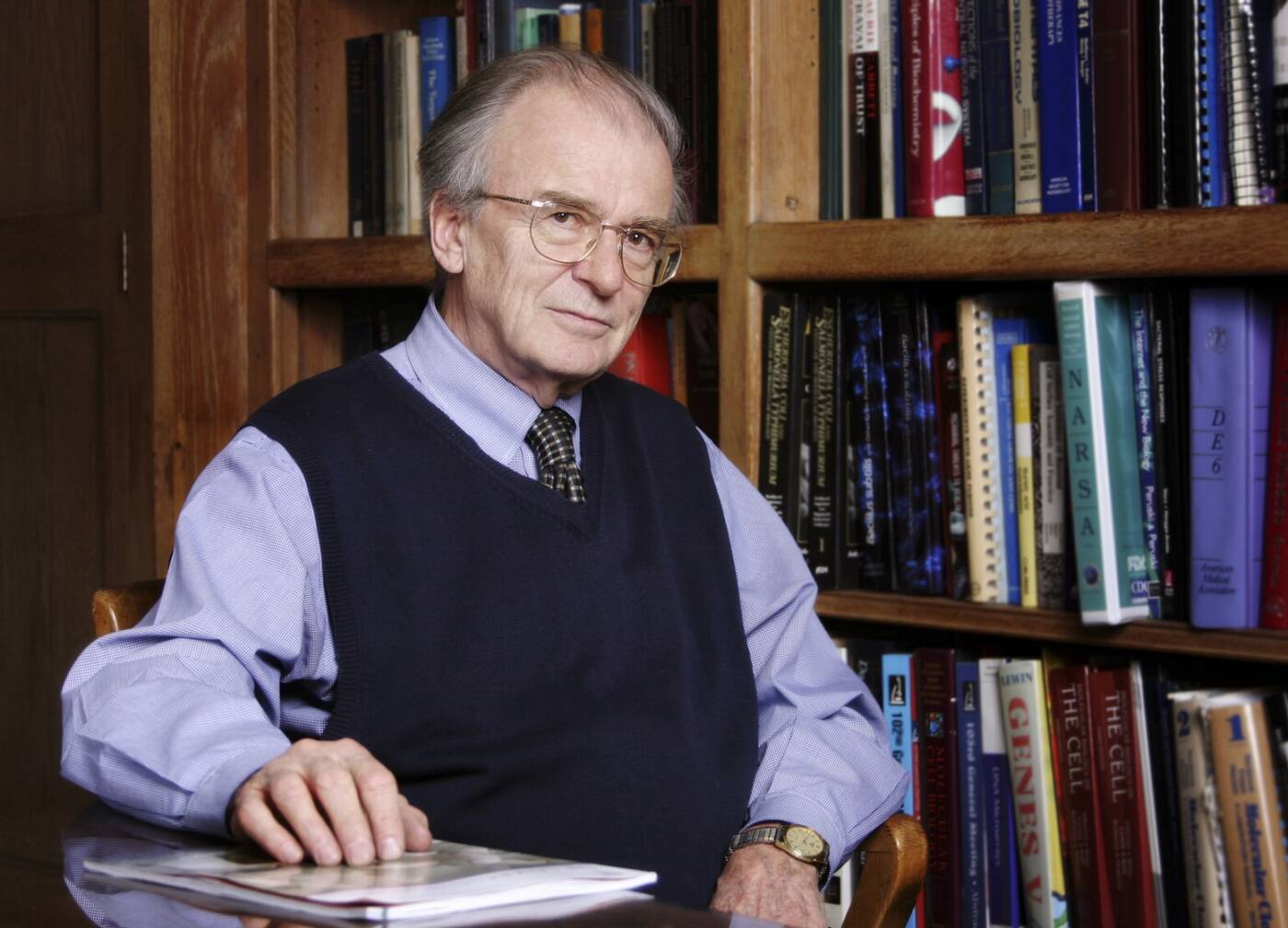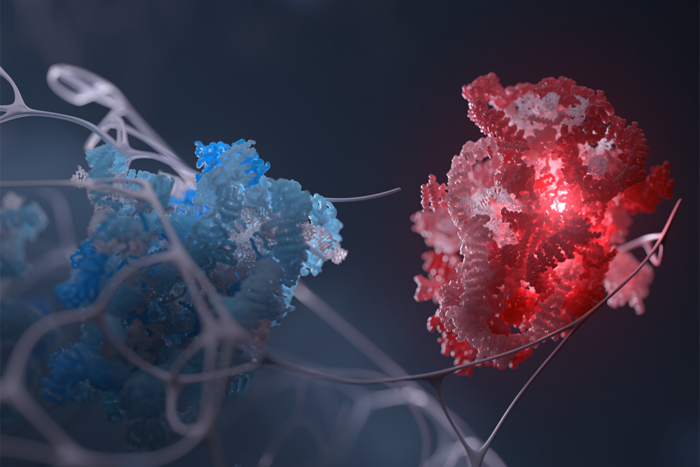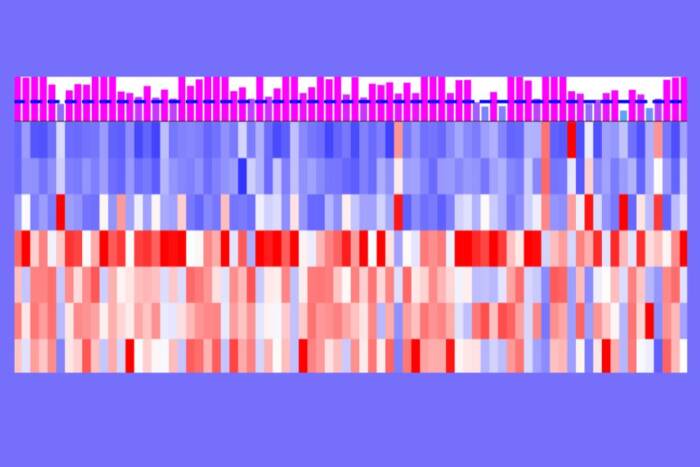Alexander Tomasz, a trailblazer in the study of multidrug-resistant microbes, has died

Alexander Tomasz in 2005.
Alexander Tomasz, a microbiologist who greatly advanced our understanding of how bacteria become resistant to antibiotics, died on September 16 at age 94. He was the Dr. Plutarch Papamarkou Professor and head of the Laboratory of Microbiology and Infectious Diseases.
“Alex was a pioneer in uncovering the mechanisms behind bacterial resistance to antibiotics,” says Vincent A. Fischetti, a Rockefeller professor and head of the Laboratory of Bacterial Pathogenesis and Immunology, adding that Tomasz’s work, which focused mainly on Streptococcus pneumoniae and Staphylococcus aureus, organisms responsible for a significant portion of bacterial-related deaths around the world, was crucial for the development of new drugs to combat these dangerous pathogens.
“He was also incredibly generous with his time, frequently welcoming young researchers and students from around the world into his lab to collaborate on various projects,” Fischetti says. “He will be deeply missed.”
“Alexander has been an indispensable member of our scientific community and a cherished friend and colleague,” Richard P. Lifton, the university’s president, wrote in an email to the community. “His research was pivotal, ultimately contributing to better management of bacterial infections in a world where antibiotic resistance is a major threat to public health.”
Tomasz arrived at Rockefeller in 1964, at an auspicious time. Some of his new colleagues had recently discovered that S. pneumoniae could transform itself from an innocuous microbe to a virulent one by absorbing foreign DNA from its environment, a phenomenon called competence. But they hadn’t been able to explain how the bacterium, which causes pneumonia, meningitis, and blood infections, accomplished this deadly trick.
Tomasz, for his part, was fascinated by the bacterial cell wall, a complex structure that doesn’t just close the cell off and protect it, like the term implies, but also brings in nutrients and other external molecules. He began searching for hidden doors in the cell walls of S. pneumoniae, hoping to deduce how these microbes capture fragments of foreign DNA floating by.
Tomasz never found those doors. But he did discover the key that unlocks them—namely, a signaling molecule that S. pneumoniae cells secrete to induce competence in their neighbors. This manner of cell-to-cell communication, now known as quorum sensing, enables one virulent cell to spread its ability to engulf DNA through the entire population, making it considerably more dangerous.
His findings furnished the first evidence that bacteria can “talk” to one another using chemical signals, much like animal cells communicate via hormone signaling. Quorum sensing has since been shown to regulate gene expression across many species of bacteria.
Subsequently, Tomasz discovered a number of strategies that bacteria use to thwart chemicals designed to kill them. For example, he showed how specific mutations in S. pneumoniae induce tolerance to penicillin, and how other mutations in Staphylococcus aureus, the pathogen that causes Staph infections, enables that organism to pick up genes from other bacteria and acquire resistance to methicillin and vancomycin (while tolerance merely allows a microbe to survive in the presence of a drug that may nevertheless curb its growth, resistance means it has become totally unaffected by the compound and will continue to thrive and spread disease.)
Moreover, Tomasz’s work uncovered some of the most fundamental principles allowing bacteria to stay ahead of the game in their constant battle against fellow species or human-made toxins. For example, he showed how microbes may alter the structure of their cell walls to become less susceptible to beta-lactams, a group of antibiotics that includes penicillin, or how they may start making enzymes that destroy antibiotics. He also contributed to the understanding of how resistance-conferring genes are transmitted and exchanged among bacteria such as methicillin-resistant S. aureus, or MRSA, a leading cause of life-threatening infections both in and outside of hospitals.
As new genomic technologies emerged, Tomasz bolstered his efforts to track and understand pathogens. With the advent of molecular fingerprinting, for example, he and his collaborators launched the CEM-NET Initiative, an international network to study the molecular epidemiology of drug-resistant pathogens. The initiative demonstrated the widespread presence of multidrug-resistant microbes in hospitals in New York City as well as in Europe, South America, and Asia, and gave researchers from different countries the opportunity to receive training in molecular typing. And when whole-genome sequencing became available, Tomasz’s lab used it to trace the evolution of bacteria in a patient who had contracted a highly dangerous strain of S. aureus while undergoing chemotherapy. The results, obtained in collaboration with Eric A. Siggia’s lab, provided a timeline of the chain of genetic events that had made the pathogen resistant to several antibiotics.
Beyond shedding light on the basic biology of microorganisms, Tomasz’s investigations provided fresh leads for designing new antibiotics and even helping to test them. In 2008, for example, he and his colleagues showed that a novel beta-lactam killed even the most highly resistant strains of S. aureus. This discovery would inform the treatment of bacterial infections in a very direct way by demonstrating that even our oldest type of antimicrobial weapon remains potentially useful—and might save the day when more modern drugs fail.
Indeed, Tomasz’s scientific approach was informed as much by pragmatism as an inherent fascination with the universe of cells and molecules. “People often think of a laboratory as remote, unreal place,” he once said, adding that his own experience demonstrated “the closeness of the world of test tubes and research, and the ‘real’ world of clinics and medicine.”
Alexander Tomasz was born in Budapest, Hungary in 1930 and considered a career in music before studying biology and chemistry at the University of Budapest. After the Soviet Union suppressed the Hungarian Uprising of 1956, he fled to Austria in a canvas-covered farm truck and eventually landed in New York, where he found work as a technician at the Sloan-Kettering Institute, which today is part of the Memorial Sloan Kettering Cancer Center.
After earning his PhD in biochemistry at Columbia University in 1963, Tomasz came to Rockefeller, then known as The Rockefeller Institute. He initially worked as a postdoctoral fellow in the laboratory of biochemist Rollin Hotchkiss, who conducted pioneering research on DNA, antibiotic resistance, and bacterial genetics. Tomasz became an assistant professor in 1964, an associate professor in 1967, and a full professor and head of laboratory in 1973. In 1998, he was named to an endowed chair in infectious diseases honoring the late Greek microbiologist Plutarch Papamarkou.
In addition to his many and varied research projects, Tomasz frequently volunteered his expertise on antibiotic resistance in the service of public health.
In 1994, for example, he helped establish the Bacterial Antibiotic Resistance Group, which sought to track resistant strains of bacteria in New York City hospitals with the support of the city’s health department. In 1999, he contributed to a state Senate Investigations Committee report that found more than half of all drug-resistant bacterial infections in New York State were acquired in hospitals due to poor hygiene practices. And in 2012, he joined a group of leading scientists and physicians that supported passage of legislation to withdraw the use of antibiotics critical to human health from use in food-producing animals.
Tomasz received the first Hoechst-Roussel Award in antimicrobial chemotherapy from the American Society for Microbiology and the Selman A. Waksman Award from the Waksman Foundation for Microbiology.
He is survived by his wife and scientific collaborator for 35 years, Herminia de Lencastre, and their four children: Martin Tomasz, Alexandre de Lencastre, Julie Tomasz, and Pedro de Lencastre.


